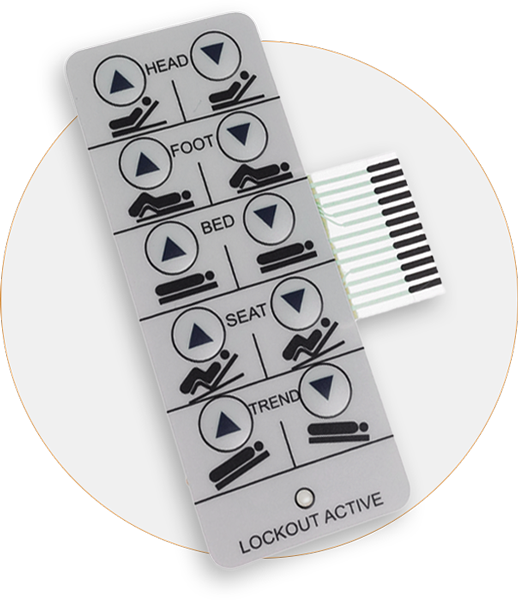Discover Exactly How a Membrane Switch Boosts Resilience and Functionality in Devices
Discover Exactly How a Membrane Switch Boosts Resilience and Functionality in Devices
Blog Article
Comprehending the Performance of Membrane Changes for Interface Tools
The performance of membrane layer changes stands for a significant advancement in customer interface design, combining efficiency with visual adaptability. As sectors significantly focus on individual experience, comprehending the nuances of membrane switch modern technology becomes essential.
What Are Membrane Layer Switches?
Membrane layer switches are innovative user interface gadgets that help with individual interaction with digital devices. These functional components include numerous layers, including a graphic overlay, spacer, and a printed circuit layer. The style enables for a seamless assimilation right into various digital tools, improving both the visual and useful elements of interface.
Membrane switches are generally employed in a vast array of applications, from household home appliances to industrial machinery and medical tools. Their building usually includes a slim account, making them an optimal option for compact layouts. The responsive responses supplied by these buttons can be engineered to fulfill details individual choices, guaranteeing efficient communication in between the user and the tool.
Toughness is one more considerable advantage of membrane switches, as they are resistant to dust, wetness, and chemicals, which improves their life expectancy sought after environments. In addition, these buttons can be tailored in regards to form, size, and graphic design, enabling branding and user-specific functions. On the whole, membrane switches represent a functional service for improving customer experience in digital tools, integrating capability with aesthetic allure in an efficient way.
Exactly How Membrane Changes Work
Operating on a simple concept, membrane layer switches use a layered building and construction to register customer input properly. Each switch is composed of numerous layers, consisting of a printed circuit layer, a spacer layer, and a leading visuals layer, which are developed to collaborate seamlessly. When an individual presses the top layer, it presses the spacer layer, bringing the conductive components of the circuit layer into contact with each various other.
This contact produces a shut circuit, signaling the tool to carry out a particular function. The layout enables different configurations, including responsive comments, which can improve the customer experience by giving a physical experience upon activation. The materials used in membrane buttons commonly consist of flexible substratums, such as polyester or polycarbonate, which ensure sturdiness and strength versus wear and tear.

Key Benefits of Membrane Layer Switches

Another substantial benefit is their density. Membrane layer buttons are slim and lightweight, which makes it possible for manufacturers to save area in their tools without compromising performance. This feature is especially valuable in applications where weight and quantity are crucial factors to consider.
Additionally, membrane layer buttons are immune to dirt, dampness, and chemicals, enhancing helpful resources their sturdiness. This durability expands their lifespan and reduces the need for constant replacements, causing expense savings over time.
In addition, the tactile feedback supplied by membrane buttons can be optimized to boost customer communication. They can include functions such as increased switches or audible clicks, boosting usability and customer experience.
Applications Throughout Industries
Customer user interface gadgets making use of membrane buttons prevail in a large selection of industries, showcasing their versatility and functionality. Membrane Switch. In the clinical sector, membrane buttons are indispensable to gadgets such as analysis equipment and person monitoring systems, where their longevity and convenience of cleansing are vital for preserving health criteria. Similarly, in the automobile sector, these switches are utilized in dashboard controls and infomercial systems, supplying a sleek and modern user interface for customers.
Additionally, the customer electronic devices sector gain from membrane layer switches in devices and handheld devices, where small design and straightforward user interfaces enhance customer experience. Industrial applications also utilize membrane switches for control panels in equipment and automation systems, highlighting their effectiveness and resistance to harsh settings.
In the aerospace and protection markets, membrane buttons are utilized in cabin controls and equipment, where integrity and performance under extreme conditions are paramount. Additionally, the gaming market significantly incorporates membrane switches in controllers and game makers, adding to an interesting user experience. Generally, the adaptability of membrane layer changes enables their extensive use across various industries, underscoring their relevance in modern-day interface style.
Future Trends in Membrane Change Innovation

Additionally, the usage of advanced materials, such as polycarbonate and polyester movies, is expected to rise, providing boosted toughness and resistance to environmental stress click here for info factors. These materials add to the total longevity of membrane layer switches, making them appropriate for harsher industrial applications.
In addition, the consolidation of smart technology, including IoT connectivity, will allow membrane layer buttons to interact with other devices and systems, promoting a more interactive individual experience. This fad straightens with the expanding demand for wise devices across different markets, from medical care to customer electronic devices.
Lastly, customization options are anticipated to broaden, allowing manufacturers to produce bespoke remedies customized to certain individual needs and choices. These growths will place membrane buttons as necessary elements in the evolution of interface modern technology.
Conclusion
To conclude, membrane changes represent an essential improvement in interface Full Report innovation, using a reliable and functional solution for varied electronic applications. Their layered building helps with compact style, while functions such as tactile comments boost customer communication. The durability versus environmental factors further strengthens their energy across multiple sectors. As improvements in product scientific research and touch noticing technologies continue, the capability and applicability of membrane layer switches are expected to increase, strengthening their relevance in modern-day digital devices.
Report this page